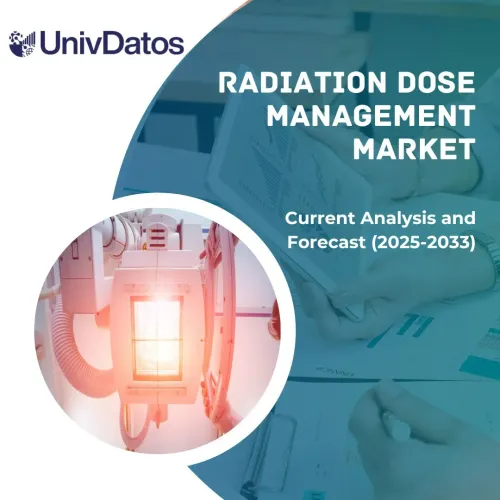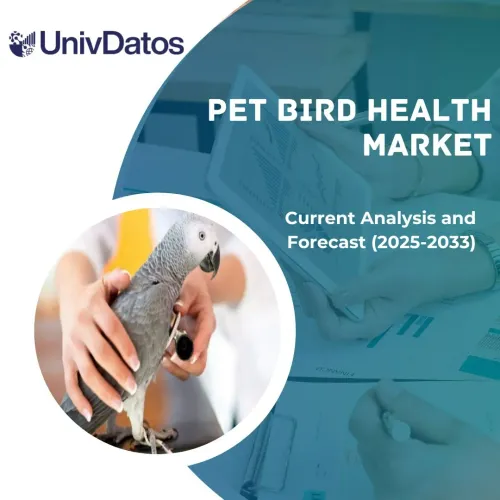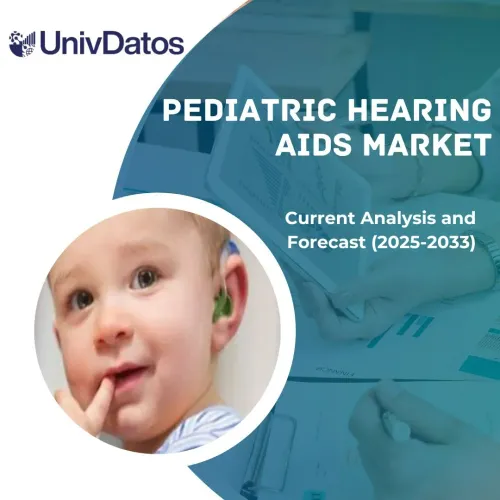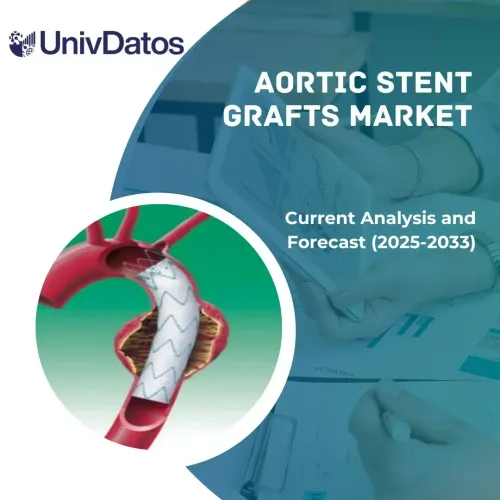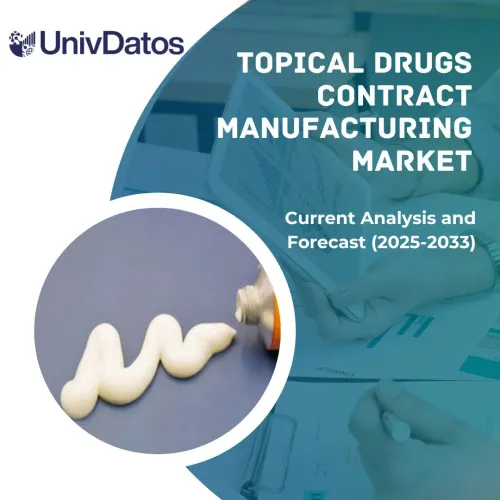- Home
- About Us
- Industry
- Services
- Reading
- Contact Us
Genome Sequencing Market: Current Analysis and Forecast (2022-2028)
Emphasis on Product (Consumables, Instruments, Services); Technology (Sanger Sequencing, Next-Generation Sequencing, Polymerase Chain Reaction, Microarrays, Others); Application (Oncology, Reproductive Health, Complex Disease Research, Drug Discovery and Development, Precision Medicine, Agriculture and Animal Research, Others); End-User (Academic & Research Centers, Pharmaceutical and Biotechnology Companies, Consumer Genomic Service Providers, Government Institutes, Others); and Region/Country
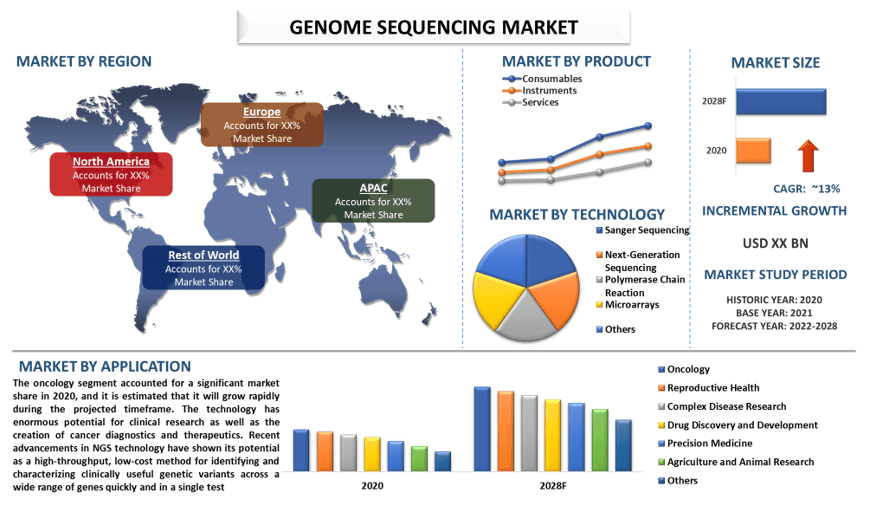
The genome sequencing market is expected to register a CAGR of approx. 13% over the period of 2022-2028. The process of mapping and sequencing a person’s individual DNA is known as genome sequencing. The term “genome” refers to the complete blueprint of a person’s human body. A person’s genes, which are a bundle of DNA, can cause a disease or increase the likelihood of disease. Genome sequencing helps to identify any significant differences in the genes, which can increase the likelihood of disease. DNA sequencing is inexpensive, has high accuracy and speed, and can produce results from small samples. DNA sequencing technologies have advanced from the first to the third generation. Because of their features, DNA sequencing systems have gained traction, which may have a positive impact on the DNA sequencing market. The growing demand for genome sequencing can be attributed to the growing emphasis on NGS-based diagnostics and surging incidences of cancer across the globe. For instance, the number of cancer cases in the US will increase 49% each year, from 1,534,500 in 2015 to 2,286,300 in 2050, with the largest percentage increase among adults aged ≥75 years, as per the predictions by CDC. Owing to the glaring statistics the increase in cancer prevalence has created a buzz among biotechnology and pharmaceutical companies for investing in the development of effective and reliable diagnostic tools which boosts the demand for genome sequencing across the globe and would contribute to the growth of the market in the forthcoming period as well. Furthermore, the genome sequencing market is anticipated to grow on account of the rapid advancements in sequencing technology and bioinformatics. In addition, changes in lifestyle and various health-related issues drive market growth. However, some of the restraints in the market including the Lack of trained professionals and the high cost of establishing and maintaining a sequencing facility are impeding the growth of this market all over the world.
Agilent Technologies Inc; Thermo Fisher Scientific, Inc.; Illumina, Inc.; Qiagen NV; BGI Genomics Co Ltd; Oxford Nanopore Technologies PLC; Macrogen Inc; PerkinElmer, Inc.; Pacific Biosciences of California Inc; Bio-Rad Laboratories, Inc are some of the key players in the market. Several M&As along with partnerships have been undertaken by these players to facilitate customers with hi-tech and innovative products/technologies.
Insights Presented in the Report
“Amongst product, the consumables category led the market in 2020 with the highest market share”
Based on the product, the genome sequencing market is segmented into consumables, instruments, and services. The consumables segment accounted for a significant market share and it is estimated that it will grow rapidly during the projected timeframe. A larger share of the segment is attributed to the broad availability of reagents and kits to address all stages of library construction, including DNA fragmentation, enrichment, adapter ligation, amplification, and quality control. The majority of these tools support low-input and formalin-fixed specimens and have streamlined and simplified workflows, ready-to-use components, and components.
“Amongst technology, the next-generation sequencing category led the market in 2020 with the highest market share”
Based on the technology, the market is fragmented into sanger sequencing, next-generation sequencing, polymerase chain reaction, microarrays, and others. The next-generation sequencing segment grabbed a considerable market share, and it is expected to grow at a significant CAGR during the forecast period. The rapid advancements in these technologies, combined with the decreasing cost of sequencing, have made genome sequencing faster, more affordable, and more accurate. Additionally, the use of NGS technology for routine clinical diagnostic tests is growing, especially in light of the COVID-19 infection pandemic, which benefits the segment’s revenue share.
“Amongst applications, the oncology category is expected to hold considerable market share during the forecast period”
Based on the application, the market is fragmented into oncology, reproductive health, complex disease research, drug discovery and development, precision medicine, agriculture and animal research, and others. The oncology segment grabbed a considerable market share, and it is expected to grow at a significant CAGR during the forecast period. The technology has enormous potential for clinical research as well as the creation of cancer diagnostics and therapeutics. Recent advancements in NGS technology have shown its potential as a high-throughput, low-cost method for identifying and characterizing clinically useful genetic variants across a wide range of genes quickly and in a single test.
“Amongst end-user, the academic & research centers category is expected to witness considerable CAGR during the forecast period”
Based on the end-user, the market is fragmented into academic & research centers, pharmaceutical and biotechnology companies, consumer genomic service providers, government institutes, and others. The academic & research centers segment grabbed a considerable market share, and it is expected to grow at a significant CAGR during the forecast period. Sanger technology and NGS are widely used in academic and institutional research projects because of their widespread acceptance. Additionally, an increase in funding and investment initiatives boosts the demand for DNA sequencing products in these organizations, leading to a higher revenue share.
“North America to witness significant growth during the forecast period”
For a better understanding of the market adoption of the genome sequencing, the market is analyzed based on its worldwide presence in the countries such as North America (U.S., Canada, and Rest of North America), Europe (Germany, France, Italy, Spain, U.K., and Rest of Europe), Asia-Pacific (China, Japan, India, Australia, and Rest of APAC), and Rest of World. North America constitutes a major market for the genome sequencing industry owing to the continuous technological developments by key players, high investment in R&D, availability of technologically advanced healthcare infrastructure, rising need for personalized medicine and the presence of several government initiatives in the U.S. and Canada supports research in drug development and treatment of cancer.
Reasons to buy this report:
- The study includes market sizing and forecasting analysis validated by authenticated key industry experts.
- The report presents a quick review of overall industry performance at one glance.
- The report covers an in-depth analysis of prominent industry peers with a primary focus on key business financials, product portfolio, expansion strategies, and recent developments.
- Detailed examination of drivers, restraints, key trends, and opportunities prevailing in the industry.
- The study comprehensively covers the market across different segments.
- Deep dive regional level analysis of the industry.
Customization Options:
Global genome sequencing market can further be customized as per the requirement or any other market segment. Besides this, UMI understands that you may have your own business needs, hence feel free to connect with us to get a report that completely suits your requirements.
Table of Content
Research Methodology for the Global Genome Sequencing Market Analysis (2022-2028)
Analyzing the historical market, estimation of the current market, and forecasting the future market of the global genome sequencing market were the three major steps undertaken to create and analyze the adoption of genome sequencing in major regions globally. Exhaustive secondary research was conducted to collect the historical market numbers and estimate the current market size. Secondly, to validate these insights, numerous findings and assumptions were taken into consideration. Moreover, exhaustive primary interviews were also conducted, with industry experts across the value chain of the global genome sequencing market. Post assumption and validation of market numbers through primary interviews, we employed a top-down/bottom-up approach to forecasting the complete market size. Thereafter, market breakdown and data triangulation methods were adopted to estimate and analyze the market size of segments and sub-segments the industry pertains to. Detailed methodology is explained below:
Analysis of Historical Market Size
Step 1: In-Depth Study of Secondary Sources:
Detail secondary study was conducted to obtain the historical market size of the genome sequencing market through company internal sources such as annual report & financial statements, performance presentations, press releases, etc., and external sources including journals, news & articles, government publications, competitor publications, sector reports, third-party database, and other credible publications.
Step 2: Market Segmentation:
After obtaining the historical market size of the genome sequencing market, we conducted a detailed secondary analysis to gather historical market insights and share for different segments & sub-segments for major regions. Major segments included in the report as the product, technology, applications, and end-users. Further country-level analyses were conducted to evaluate the overall adoption of testing models in that region.
Step 3: Factor Analysis:
After acquiring the historical market size of different segments and sub-segments, we conducted a detailed factor analysis to estimate the current market size of the genome sequencing market. Further, we conducted factor analysis using dependent and independent variables such as the growing emphasis on NGS-based diagnostics and surging incidences of cancer, etc. globally. A thorough analysis was conducted for demand and supply-side scenarios considering top partnerships, mergers and acquisitions, business expansion, and product launches in the genome sequencing market sector across the globe.
Current Market Size Estimate & Forecast
Current Market Sizing: Based on actionable insights from the above 3 steps, we arrived at the current market size, key players in the global genome sequencing market, and market shares of the segments. All the required percentage shares split, and market breakdowns were determined using the above-mentioned secondary approach and were verified through primary interviews.
Estimation & Forecasting: For market estimation and forecast, weights were assigned to different factors including drivers & trends, restraints, and opportunities available for the stakeholders. After analyzing these factors, relevant forecasting techniques i.e., top-down/bottom-up approach was applied to arrive at the market forecast about 2027 for different segments and sub-segments across the major markets globally. The research methodology adopted to estimate the market size encompasses:
- The industry’s market size, in terms of revenue (USD) and the adoption rate of the genome sequencing market across the major markets domestically
- All percentage shares, splits, and breakdowns of market segments and sub-segments
- Key players in the global genome sequencing market in terms of solutions offered. Also, the growth strategies adopted by these players to compete in the fast-growing market
Market Size and Share Validation
Primary Research: In-depth interviews were conducted with the Key Opinion Leaders (KOLs) including Top Level Executives (CXO/VPs, Sales Head, Marketing Head, Operational Head, and Regional Head, Country Head, etc.) across major regions. Primary research findings were then summarized, and statistical analysis was performed to prove the stated hypothesis. Inputs from primary research were consolidated with secondary findings, hence turning information into actionable insights.
Split of Primary Participants in Different Regions

Market Engineering
Data triangulation technique was employed to complete the overall market estimation and to arrive at precise statistical numbers of each segment and sub-segment of the global genome sequencing market. Data was split into several segments & sub-segments post studying various parameters and trends in the areas of product, technology, applications, end-users in the global genome sequencing market.
The main objective of the Global Genome sequencing Market Study
The current & future market trends of the global genome sequencing market were pinpointed in the study. Investors can gain strategic insights to base their discretion for investments on the qualitative and quantitative analysis performed in the study. Current and future market trends determined the overall attractiveness of the market at a regional level, providing a platform for the industrial participant to exploit the untapped market to benefit as a first-mover advantage. Other quantitative goals of the studies include:
- Analyze the current and forecast market size of the genome sequencing market in terms of Value (USD). Also, analyze the current and forecast market size of different segments and sub-segments
- Segments in the study include areas of product, technology, applications, end-users.
- Define and analysis of the regulatory framework for the genome sequencing market industry.
- Analyze the value chain involved with the presence of various intermediaries, along with analyzing customer and competitor behaviors of the industry.
- Analyze the current and forecast market size of the genome sequencing market for the major region.
- Major countries of regions studied in the report include Asia Pacific, Europe, North America, and Rest of the world.
- Company profiles of the genome sequencing market and the growth strategies adopted by the market players to sustain in the fast-growing market
- Deep dive regional level analysis of the industry
Related Reports
Customers who bought this item also bought

